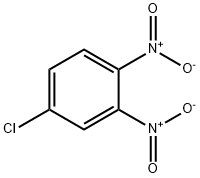1-클로로-3,4-디니트로벤젠
|
|
1-클로로-3,4-디니트로벤젠 속성
- 녹는점
- 40-41 °C
- 끓는 점
- 16 °C (4 mmHg)
- 밀도
- 1.687 g/mL at 25 °C(lit.)
- 굴절률
- n
20/D 1.587(lit.)
- 인화점
- >230 °F
- 저장 조건
- 0-10°C
- 물리적 상태
- 기름진 액체
- 색상
- 옐로우 브라운 컬러
- 수용성
- 불용성
- BRN
- 521564
- CAS 데이터베이스
- 610-40-2(CAS DataBase Reference)
안전
- 위험 및 안전 성명
- 위험 및 사전주의 사항 (GHS)
| 위험품 표기 | T,N | ||
|---|---|---|---|
| 위험 카페고리 넘버 | 23/24/25-33-50/53 | ||
| 안전지침서 | 28-36/37-45-60-61-28A | ||
| 유엔번호(UN No.) | UN 3441 6.1/PG 2 | ||
| WGK 독일 | 3 | ||
| TSCA | Yes | ||
| 위험 등급 | 6.1 | ||
| 포장분류 | II | ||
| HS 번호 | 2904990090 |
1-클로로-3,4-디니트로벤젠 C화학적 특성, 용도, 생산
개요
Securinine is derived from the leaf of Securinega suffruticosa Rehd., which was first separated by V.I.?Murav’eva in 1956 . Securinega suffruticosa Rehd., a kind of subshrub plant, is widely distributed in temperate and subtropical regions . It has strong adaptability and can be planted in most parts of China. Moreover, it is rich in natural resources. Securinega suffruticosa Rehd. is a folk medicine whose root is the main component, with the effects of activating circulation, spleen, and stomach to treat rheumatism waist pain, limb numbness, infant malnutrition, and other diseases. The roots, stems, leaves, flowers, and skin of Securinega suffruticosa Rehd. contain alkaloids, in which securinine is the main ingredient.화학적 성질
YELLOW-BROWN OILY LIQUID AFTER MELTING물리적 성질
Appearance: yellow crystalline powder, slightly bitter. Solubility: soluble in anhydrous ethanol or chloroform, insoluble in water. Melting point: 139–140?°C Specific optical rotation: (D) ?1042°(C?=?1, EtOH).역사
Securinine was first isolated by a Soviet scholar from the Wusuli region, but its chemical structure was separated and finally determined by Chinese scholars from local sources . The main structural feature is a tetracyclic compound containing an indolizine, pyrrole elidine, or quinolizine ring and an α, β-unsaturated pentahydrin ring whose basic structural skeleton type is as shown in what follows .Owing to the complexity of the chemical reaction of securinine, reports on its chemical reactivity and structural modification have been relatively scarce since securinine was reported on in 1956. However, the research on chemical total synthesis and biological activities of securinine has made a certain amount of progress.
Securinine has a rigid molecular structure containing four rings and three chiral centers, which makes synthesis difficult. From 1974 to 1978, three research groups from Japan, the USA, and Canada studied the biosynthesis of securinine by feeding animals with isotope-labeled S. suffruticosa.
용도
3,4-Dinitrochlorobenzene is a useful reactant in organic synthesis.Indications
Poliomyelitis sequela and facial paralysis, neurasthenia, hypotension, autonomic dysfunction, and othersPharmacology
The pharmacological effect of securinine is mainly manifested as a central nervous system excitatory effect. As a GABA receptor inhibitor, it has an excitatory effect similar to that of strychnine on the spinal cord. A low dose of securinine can improve the excitability of brain reflection, while a high dose of securinine will cause febrile seizures, and at the same time securinine can strengthen the conditioned reflex of the cerebral cortex, shorten the latency period, and promote learning and memory capability , and so it is expected to be a promising drug for the treatment of Alzheimer’s disease.,Securinine can improve the hematopoietic environment of patients with aplastic anemia, promote cell proliferation, have a synergistic anti-tumor effect in combination with cyclophosphamide (CTX), and can antagonize bone marrow suppression caused by CTX.?It has an inhibitory effect on cell proliferation of human leukocyte cell K562 and four other kinds of tumor cells.
Clinical Use
In recent years, securinine has been widely used in clinical practice, mainly for the treatment of polio sequelae and facial nerve palsy. It also has a certain effect on neurasthenia, hypotension and dizziness, tinnitus, and deafness caused by autonomic dysfunction. The nitrate and hydrochloride of left-handed securinine are mainly used clinically. In addition, securinine eye drops are found to have a remarkable effect on the treatment of herpes simplex keratitis through initial clinical observation.1-클로로-3,4-디니트로벤젠 준비 용품 및 원자재
원자재
준비 용품
1-클로로-3,4-디니트로벤젠 공급 업체
글로벌( 101)공급 업체
| 공급자 | 전화 | 이메일 | 국가 | 제품 수 | 이점 |
|---|---|---|---|---|---|
| Hubei Jusheng Technology Co.,Ltd. | 18871490254 |
linda@hubeijusheng.com | CHINA | 28180 | 58 |
| Alchem Pharmtech,Inc. | 8485655694 |
sales@alchempharmtech.com | United States | 63711 | 58 |
| CONIER CHEM AND PHARMA LIMITED | +8618523575427 |
sales@conier.com | China | 49390 | 58 |
| SIMAGCHEM CORP | +86-13806087780 |
sale@simagchem.com | China | 17367 | 58 |
| Career Henan Chemica Co | +86-0371-86658258 15093356674; |
laboratory@coreychem.com | China | 30255 | 58 |
| Hefei TNJ Chemical Industry Co.,Ltd. | 0551-65418671 |
sales@tnjchem.com | China | 34572 | 58 |
| Dayang Chem (Hangzhou) Co.,Ltd. | 571-88938639 +8617705817739 |
info@dycnchem.com | CHINA | 52867 | 58 |
| Shaanxi Didu New Materials Co. Ltd | +86-89586680 +86-13289823923 |
1026@dideu.com | China | 9116 | 58 |
| Hebei Duling International Trade Co. LTD | +8618032673083 |
sales05@hbduling.cn | China | 15745 | 58 |
| Hebei Guanlang Biotechnology Co., Ltd. | +86-19930503259 +86-19930503259 |
cherry@crovellbio.com | China | 18456 | 58 |










